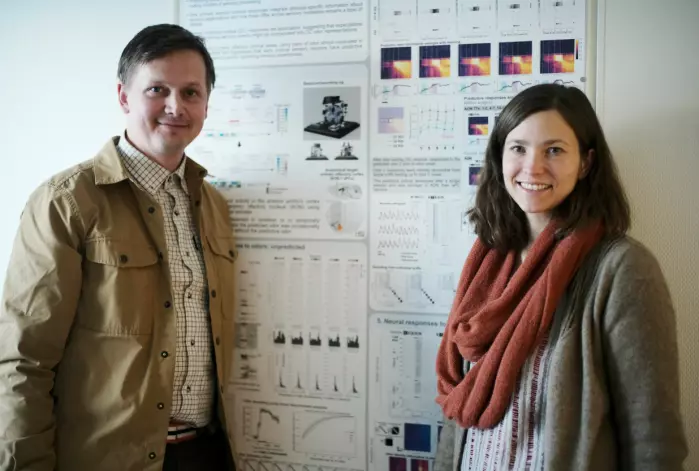Do you get flashbacks of Christmas memories from the past when you smell the scent of clementines, mulled wine or gingerbread? This is not a coincidence.
“When you smell the fragrance of an orange, for example, it is your memories that create the exact scent,” neuroscientist Hanne Stensola explains.
Married couple Hanne and Tor Stensola have been all over the world with the world’s most outstanding neuroscientists. Now they have settled down in their hometown of Kristiansand, to establish a new neuroscience environment at the University of Agder (UiA).
Fragrances go straight to the hippocampus
You may have felt the nostalgic Christmas atmosphere of your childhood from the combination of gravy, mulled wine and clementines.
It is no coincidence, given that the sense of smell is directly linked to the area of the brain that stores memories, the hippocampus.
“You need memories to give meaning to a smell, but you don’t need memories to give meaning to what you see,” explains Tor Stensola.
To rephrase: There is substantial research behind why an artificial tree can never evoke the same Christmas feelings as a freshly cut tree with fragrant needles and resin.
But when the Stensolas chose to study the olfactory system of the brain, it is not because they are particularly interested in scent. The reason is much more pragmatic.
To understand why, we need to take a deep dive into a world of research involving a single brain cell dedicated to Jennifer Aniston, and the similarity between vomit and parmesan.
Welcome to the brain.

The best model system
“We are not interested in smell per se, although the sense of smell is interesting – we are interested in the process that takes place in the olfactory system, which actually also happens elsewhere. But it is easier to work with smell. You have to choose your model system carefully,” Tor Stensola explains.
Researchers need good model systems. What we sense is a mixture of external and internal influences, which means that we all have a unique experience of the same external world.
The Stensolas explain it this way:
External influences are what hit your sensory organs, while internal influences are shaped by memories, expectations, or your mood at the time. To understand how our inner self helps shape everything we sense, it is easiest to work with smell.
Smells are fully processed as a mixture of external and internal influences at the first step in the cerebral cortex. Visual impressions, on the other hand, have to go through several steps before the object you see – and not just lines and colours – appears.
“The ultimate goal is to understand the human brain, but if you want to understand how the brain recognises objects and creates categories, you must understand the basic functions of the system. We can only reach this level of detail through animal research. This means we should choose a system based on the animal model we use, and if we are going to study mice, the olfactory system is a good choice,” Hanne Stensola explains.
How does the brain assign identity?
And this is where it gets a little complicated. That’s why it’s okay to throw in a popular celebrity from a well-known article among bneuroscientists. This is where Jennifer Aniston comes into the picture.
When performing surgery on epilepsy patients, it is important not to remove too much tissue and affect the patient’s function, but enough tissue to make the seizures cease.
Stensola refers to something called the Montreal Procedure.
“The researchers wanted to see how the hippocampus represents celebrities. They showed some patients pictures of Jennifer Aniston and found a cell that was only active when pictures of her were shown, a separate Jennifer Aniston cell in fact. Once Brad Pitt was in the picture, however, the cell stopped being active. Maybe he was some kind of blocker,” Tor Stensola says.
The photos of Jennifer Aniston were taken from different angles, in varying lighting conditions and in different outfits. The conclusion therefore was that the cell activity was linked to identity. Just like you would recognise your mother wearing a fake moustache and a wig.
The mystery is that researchers do not yet know how the brain assigns identity from all the variable sensory input. The goal of the Stensolas’ research is to find answers to these questions by studying the olfactory system.
“Our question is how the brain categorises sensory input. And that’s why we study mice and smell, because do you know how this happens? It doesn’t happen 1-2-3-4-5-6 steps away, it happens two steps away in the first part of the cerebral cortex,” Tor Stensola says.
Trauma and smell
The identity of an orange in your brain is two different things depending on whether the smell of citrus is mixed with the smell of a campfire and hotdogs, or if the smell of citrus is mixed with the smell of mulled wine, fir trees and grandpa’s Old Spice. It is as different as Easter and Christmas.
Since the sense of smell is right next to our memory in the brain, and is so immediate, smell is particularly strongly linked to both good and bad memories.
“The brain likes to generalise and stamp impressions on the memory for safety reasons. If you eat an orange just before a serious car accident, your brain doesn’t know if the orange was to blame,” Tor Stensola says.
And this is where the amygdala, the fear centre of the brain, comes into the picture. This part of the brain is associated with survival and is what triggers the fight or flight response in the nervous system. That is why the amygdala labels all the details related to traumatic events as ‘very important.’
“The problem with trauma memories that invoke anxiety is that it becomes generalised. The brain doesn’t care about your rational thoughts. In an evolutionary perspective, an overreaction is better than no reaction. This makes it difficult for us humans since cognitive resolution is separate from emotional resolution,” he says.
It can be difficult to reason with yourself and try to ignore a smell that the brain associates with something traumatic. However, research on mice has shown that there is help to be had, by stimulating new responses associated with the smell.
New lab under construction
When the laboratory at UiA is completed in 2023, we can expect to see more research.
“The close connection between the olfactory and memory systems in the brain makes it likely that the interwoven factors that form our experiences, and our memories of them, also help to shape the olfactory representations. Thus, subsequent exposure to a smell will create an internal representation both of the smell and of the memories associated with it. Olfactory representations and memories are quite simply interlinked. How this happens is one of the many issues we will explore once the lab is up and running,” Hanne Stensola concludes.













